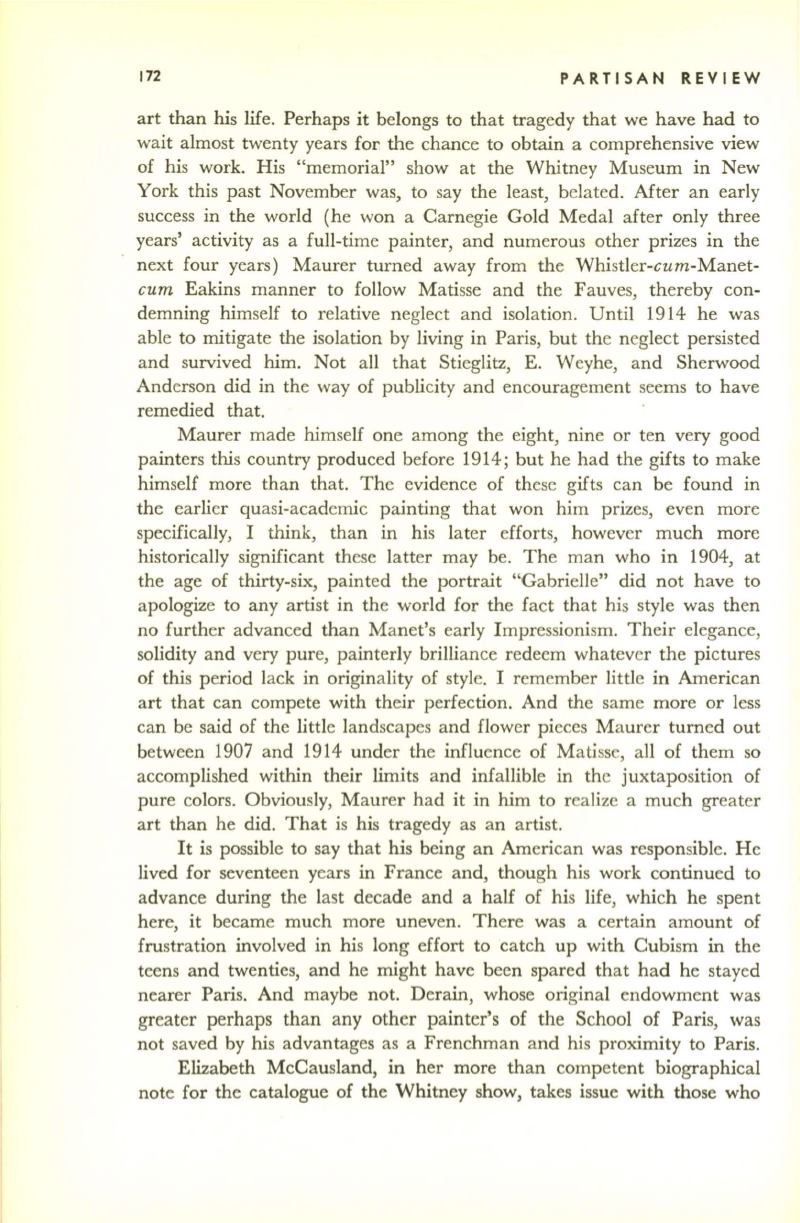
172
PARTISAN REVIEW
art than his life. Perhaps it belongs to that tragedy that we have had to
wait almost twenty years for the chance to obtain a comprehensive view
of his work. His "memorial" show at the Whitney Museum in New
York this past November was, to say the least, belated. After an early
success in the world (he won a Carnegie Gold Medal after only three
years' activity as a full-time painter, and numerous other prizes in the
next four years) Maurer turned away from the Whistler-cum-Manet–
cum
Eakins manner to follow Matisse and the Fauves, thereby con–
demning himself to relative neglect and isolation. Until 1914 he was
able to mitigate the isolation by living in Paris, but the neglect persisted
and survived him. Not all that Stieglitz, E. Weyhe, and Sherwood
Anderson did in the way of publicity and encouragement seems to have
remedied that.
Maurer made himself one among the eight, nine or ten very good
painters this country produced before 1914; but he had the gifts to make
himself more than that. The evidence of these gifts can be found in
the earlier quasi-academic painting that won him prizes, even more
specifically, I think, than in his later efforts, however much more
historically significant these latter may be. The man who in 1904, at
the age of thirty-six, painted the portrait "Gabrielle" did not have to
apologize to any artist in the world for the fact that his style was then
no further advanced than Manet's early Impressionism. Their elegance,
solidity and very pure, painterly brilliance redeem whatever the pictures
of this period lack in originality of style. I remember little in American
art that can compete with their perfection. And the same more or less
can be said of the little landscapes and flower pieces Maurer turned out
between 1907 and 1914 under the influence of Matisse, all of them so
accomplished within their limits and infallible in the juxtaposition of
pure colors. Obviously, Maurer had it in him to realize a much greater
art than he did. That is his tragedy as an artist.
It is possible to say that his being an American was responsible. He
lived for seventeen years in France and, though his work continued to
advance during the last decade and a half of his life, which he spent
here, it became much more uneven. There was a certain amount of
frustration involved in his long effort to catch up with Cubism in the
teens and twenties, and he might have been spared that had he stayed
nearer Paris. And maybe not. Derain, whose original endowment was
greater perhaps than any other painter's of the School of Paris, was
not saved by his advantages as a Frenchman and his proximity to Paris.
Elizabeth McCausland, in her more than competent biographical
note for the catalogue of the Whitney show, takes issue with those who


